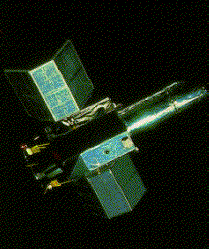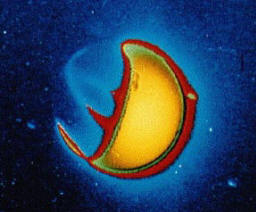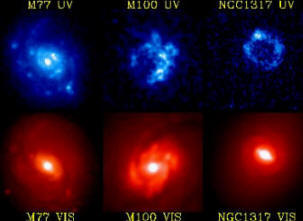It is good for humans that we are protected from getting too much ultraviolet radiation, but it is bad for scientists! Astronomers have to put ultraviolet telescopes on satellites to measure the ultraviolet light from stars and galaxies - and even closer things like the Sun!
| There are many different satellites that help us study ultraviolet astronomy. Many of them only detect a small portion of UV light. For example, the Hubble Space Telescope observes stars and galaxies mostly in near ultraviolet light. NASA's Extreme Ultraviolet Explorer satellite is currently exploring the extreme ultraviolet universe. The International Ultraviolet Explorer (IUE) satellite has observed in the far and near ultraviolet regions for over 17 years. |  |
What does Ultraviolet light show us?
We can study stars and galaxies by studying the UV light they give off - but did you know we can even study the Earth? Below is an unusual image - it is a picture of Earth taken from a lunar observatory! This false-color picture shows how the Earth glows in ultraviolet (UV) light.
| The Far UV Camera/Spectrograph deployed and left on the Moon by the crew of Apollo 16 took this picture. The part of the Earth facing the Sun reflects much UV light. Even more interesting is the side facing away from the Sun. Here, bands of UV emission are also apparent. These bands are the result of aurora caused by charged particles given off by the Sun. They spiral towards the Earth along Earth's magnetic field lines. |   |
Many scientists are interested in studying the invisible universe of ultraviolet light, since the hottest and the most active objects in the cosmos give off large amounts of ultraviolet energy.
The image below shows three different galaxies taken in visible light (bottom three images) and ultraviolet light (top row) taken by NASA's Ultraviolet Imaging Telescope (UIT) on the Astro-2 mission.


The difference in how the galaxies appear is due to which type of stars shine brightest in the optical and ultraviolet wavelengths. Pictures of galaxies like the ones below show mainly clouds of gas containing newly formed stars many times more massive than the sun, which glow strongly in ultraviolet light. In contrast, visible light pictures of galaxies show mostly the yellow and red light of older stars. By comparing these types of data, astronomers can learn about the structure and evolution of galaxies.